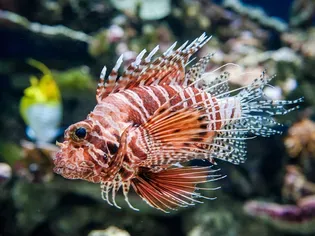Beware of Poisonous Fish in Saltwater Aquariums
Updated on 04/26/24

Beware of Poisonous Fish in Saltwater Aquariums: A Comprehensive Guide
In the captivating realm of saltwater aquariums, hobbyists revel in the vibrant display of marine life. However, beneath the shimmering surface lurks a hidden danger: poisonous fish. These stealthy creatures may appear alluring, but their venom can inflict severe consequences, ranging from minor discomfort to life-threatening emergencies.
To ensure the safety of your aquatic ecosystem and avoid potential health risks, it is crucial to be aware of the poisonous species that inhabit saltwater aquariums. This comprehensive guide will arm you with the knowledge to identify, avoid, and handle venomous fish, ensuring the well-being of both your marine inhabitants and yourself.
Anatomy of a Poisonous Fish
Venomous fish possess specialized structures that deliver their toxins. These structures can take various forms:
* Spines: Sharp, venomous spines located on the dorsal, pelvic, or anal fins.
* Teeth: Venom-injecting fangs or teeth located in the mouth or gill arches.
* Stingers: Barbed structures on the tail or operculum (gill covers).
* Glands: Venom-producing glands located on the skin or fins.
Types of Venomous Fish in Saltwater Aquariums
Saltwater aquariums harbor a wide array of venomous fish, each possessing unique venom characteristics. Some of the most commonly encountered species include:
* Lionfish: Known for their elaborate, flowing fins and venomous spines.
* Scorpionfish: Camouflaged masters of disguise with venomous spines along their dorsal and anal fins.
* Stonefish: Bottom-dwelling ambush predators with potent venom delivered through sharp dorsal spines.
* Toadfish: Pufferfish relatives with venomous glands in their skin and eyes.
* Boxfish: Cube-shaped fish with venomous spines on their pelvic and dorsal fins.
Symptoms of Venomous Fish Envenomation
Envenomation by saltwater fish can manifest in a range of symptoms, depending on the species, venom potency, and individual susceptibility. Common symptoms include:
* Localized pain, swelling, and redness
* Numbness, tingling, or burning sensations
* Nausea, vomiting, and abdominal pain
* Headache, dizziness, and confusion
* Respiratory distress, seizures, and even cardiac arrest in severe cases
Treatment for Venomous Fish Envenomation
Immediate medical attention is paramount if venomous fish envenomation is suspected. Treatment typically involves:
* First aid: Immobilizing the affected area and soaking it in hot water (not scalding) to help neutralize the venom.
* Pain relief: Administering over-the-counter pain relievers to alleviate discomfort.
* Antivenin: In severe cases, antivenin may be necessary to neutralize the venom.
* Medical monitoring: Close observation to monitor vital signs and provide supportive care as needed.
Prevention: Identifying and Avoiding Poisonous Fish
The best way to prevent venomous fish envenomation is to avoid handling or interacting with them. Here are some tips for identifying and avoiding poisonous fish in saltwater aquariums:
* Observe behavior: Venomous fish often display aggressive or defensive behaviors, such as flaring fins or erecting spines.
* Check physical appearance: Familiarize yourself with the physical characteristics of venomous fish, including their distinctive spines, teeth, or stingers.
* Research before buying: Before adding any fish to your aquarium, thoroughly research their species and potential for venom.
* Use caution when cleaning or feeding: Wear gloves and exercise caution when handling fish or performing maintenance tasks.
* Never feed live food: Live prey may carry venomous parasites or toxins that can harm your fish.
Handling Venomous Fish Safely
If it becomes necessary to handle a venomous fish, extreme caution is essential. Follow these guidelines to minimize the risk of envenomation:
* Use thick gloves and protective gear: Wear puncture-resistant gloves and other protective equipment to avoid contact with spines or teeth.
* Secure the fish properly: Use a net or container to restrain the fish firmly, preventing it from struggling or attacking.
* Avoid direct contact: Handle the fish as little as possible and keep your hands away from its mouth or spines.
* Move slowly and deliberately: Avoid sudden movements that may startle the fish and cause it to react defensively.
* Release the fish promptly: Once the handling is complete, release the fish back into its environment as quickly as possible.
Educating Yourself and Others
Knowledge is the most potent weapon against venomous fish envenomation. Educate yourself and others about the dangers of these creatures and how to avoid them. Share this information with fellow hobbyists, aquarium enthusiasts, and anyone who may interact with saltwater fish.
By being vigilant and well-informed, you can create a safe and enjoyable environment for your marine life while protecting yourself from the hidden dangers lurking in saltwater aquariums. Remember, knowledge is power, and when it comes to venomous fish, ignorance can have painful consequences.
Explore More Pets

Freshwater Aquarium Filters
How to Deal With Cloudy Aquarium Water

Saltwater Aquarium Filters
How Do You Remove Chloramines From Tap Water?

Freshwater Aquariums & Habitat
Can I Keep My Koi Fish Inside?

Saltwater Aquariums & Habitat
14 Best Floating Plants for Your Aquarium

Freshwater Fish Health
How to Treat Ich on Freshwater Fish

Saltwater Fish Health
Fin Rot in Aquarium Fish

Freshwater Aquarium Filters
How to Do Aquarium Water Changes

Saltwater Fish Health
How Do Fish Get Parasites?